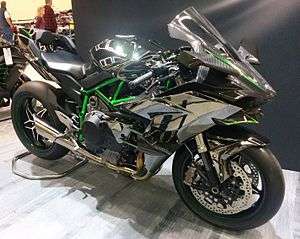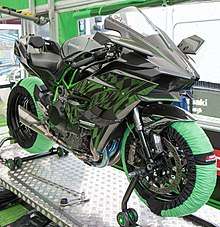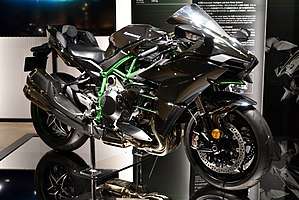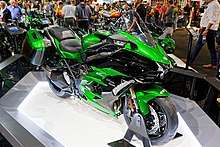Kawasaki Ninja H2
The Kawasaki Ninja H2 is a "supercharged supersport" class[8] motorcycle in the Ninja sportbike series, manufactured by Kawasaki Heavy Industries, featuring a variable-speed centrifugal-type supercharger.[9][10][11][12] The track-only variant is called Ninja H2R, and it is the fastest and most powerful production motorcycle on the market; it produces a maximum of 310 horsepower (230 kW) and 326 horsepower (243 kW) with ram air.[1] The H2R has 50% more power than the fastest street-legal motorcycles, while the street-legal Ninja H2 has a lower power output of 200 hp (150 kW)[13]–210 hp (160 kW) with ram air.[1]
 | |
| Manufacturer | Kawasaki Motorcycle & Engine Company |
|---|---|
| Parent company | Kawasaki Heavy Industries |
| Production | 2015–present |
| Class | Track-only sport bike (H2R) |
| Engine | Supercharged (two-speed centrifugal) 998 cc inline-4 DOHC |
| Bore / stroke | 76.0 mm × 55.0 mm (2.99 in × 2.17 in) |
| Compression ratio | 8.3:1[1] |
| Top speed | 331–400 km/h (206–249 mph)[1][2][3][4][5][6][7] |
| Power | 310 hp (230 kW) @14,000 rpm[1] |
| Torque | 115 lb⋅ft (156 N⋅m) @12,500 rpm[1] |
| Frame type | Steel trellis, carbon fiber bodywork |
| Suspension | Front: Fully adjustable KYB telescopic fork with steering damper Rear: single-sided swingarm with monoshock |
| Brakes | Radial-mount Brembo monoblock |
| Tires | Racing slicks Front: 120/60 R17 Rear: 190/65 R17 |
| Rake, trail | 25.1°, 110 mm (4.3 in) |
| Wheelbase | 1,450 mm (57.1 in) |
| Seat height | 830 mm (32.7 in) |
| Weight | 476.0 lb (215.9 kg)[1] (wet) |
| Fuel capacity | 17.03 l (3.75 imp gal; 4.50 US gal) |
Its namesake is the 750 cc Kawasaki H2 Mach IV,[14][15] an inline triple that was introduced by Kawasaki in 1972 to "disrupt what it saw as a sleeping motorcycle market".[16]
H2R top speed

2015
In June 2015, TT race competitor James Hillier rode a Kawasaki H2R as an inter-race demonstration lap, at near-race speeds,[17] using normal Superbike slick race tires,[18] around the 373⁄4-mile road course, leading to a roads TT record of the highest top speed attained in the Isle of Man by a motorcycle.[19] The top speed of "over 206 mph" (332 km/h) on the Sulby Straight was recorded on Hillier's personal Strava GPS smartphone app for cyclists.[20]
2016
On June 30, 2016, Kenan Sofuoglu, a five-time world champion Supersport circuit-racer, made a top speed attempt.[21][22] Kawasaki supplied a stock H2R, other than special-formula rubber tires developed by Pirelli for the top speed attempt to withstand extreme high speeds, and the bike was supplied with race-grade fuel.[23] Sofuoglu was supplied with a special one-piece leather suit to enhance aerodynamics for his record attempt.[23]
This attempt, with the Turkish president in attendance, was made across the then-newly completed Osman Gazi Bridge, the fourth longest in the world at just over a mile and a half.[24] Kawasaki quoted the H2R maximum speed to be 380 kilometres per hour (240 mph).[25] After training and preparing for four months, a speed of 400 kilometres per hour (250 mph) in just 26 seconds was claimed by a video-recording of the bike's dashboard display.[7][26][27][28]
The speed was not officially confirmed or independently verified. No fixed point optical sensors for distance/speed calculations, chronometers or hand-held devices were used,[6] and later with a theoretical calculation,[29] of the distance he traveled in 26 seconds on the 8,799-foot-long (2,682 m) bridge. Cycle World's Kevin Cameron had calculated two years earlier that with the right gearing, the H2R's engine power could theoretically overcome aerodynamic drag up to 250–260 miles per hour (400–420 km/h).[30]
Street-legal Ninja H2
 | |
| Manufacturer | Kawasaki Motorcycle & Engine Company |
|---|---|
| Parent company | Kawasaki Heavy Industries |
| Production | 2015–present |
| Class | Street-legal sport bike |
| Engine | Supercharged (two-speed centrifugal) 998 cc inline-4 DOHC 20.5 PSI boost[31] |
| Bore / stroke | 76x55 mm |
| Compression ratio | 8.5:1 |
| Top speed | 337.06 km/h (209.442 mph)[32][33] |
| Power | (2015-2018) 141.5 kW (189.8 hp) (rear wheel)[34] 150 kW (200 hp)(claimed)@11,000 rpm (2019-) 170 kW (228 hp) (claimed)[35] |
| Torque | 123.7 N⋅m (91.2 lb⋅ft) (rear wheel)[34] 133.5 N⋅m (98.5 lb⋅ft)(claimed) @10,500 rpm |
| Transmission | 6-speed |
| Frame type | Steel trellis |
| Suspension | Front: 43 mm telescopic fork, preload adj. Rear: Single shock, preload adj. |
| Brakes | Front: 2x330 mm disc Rear: 250 mm disc |
| Tires | Front: 120/70ZR17 Rear: 200/55ZR17 |
| Rake, trail | 24.5°, 4 in (100 mm) |
| Wheelbase | 1,450 mm (57.1 in) |
| Dimensions | L: 2,090 mm (82.1 in) |
| Seat height | 32.5 in (830 mm) |
| Weight | 529.0 lb (240.0 kg)[34] (wet) |
| Related | Ninja H2R |
The street-legal Ninja H2 has rear-view mirrors in place of the track-only H2R's wings.[13] It also has plastic body panels in place of the H2R's carbon fiber. The street-legal bike is said to make 200 horsepower (150 kW), probably with reduced supercharger boost compared to the H2R.[13] The H2 and H2R share the supercharger (with a lower boost level on the H2) and many other components, with the exception of head gasket, cam profile and timing with ECU mapping, and exhaust system as well as the R's clutch has two additional plates.[1] Cycle World recorded a 1/4 mile time of 9.62 sec. @ 152.01 mph (244.64 km/h) with a 0 to 60 mph acceleration at 2.6 seconds and a top speed of 183 mph (295 km/h).[34] Kent Kunitsugu, editor for Sport Rider magazine, competing in a land-speed racing event in Mojave, California at the Mojave Air and Space Port airfield in the Mojave Magnum land-speed racing, took a Ninja H2 with just a few bolt-on performance parts adding over 70 horsepower and achieved a top speed of 226.9 mph (365.2 km/h).[36][37]
For 2017, Kawasaki made a limited-edition model with 120 units produced globally: the individually-numbered Kawasaki Ninja H2 Carbon with special paint and carbon-fiber upper cowl. For 2017, the standard model Kawasaki Ninja H2 is also updated.[38]

For 2018, Kawasaki made a new sport touring version of the H2, the Kawasaki H2 SX, with a claimed wet weight of 256.1 kg (564.5 lb). Features that are options on the base model H2 SX come standard on the Kawasaki H2 SX SE, which has a claimed wet weight of 260.0 kg (573.3 lb).[39] With revised throttle bodies, camshafts, crankshaft, pistons, cylinder and cylinder head as well as a new exhaust system aimed at increasing mid range torque. The intake system and supercharger impeller were also redesigned. A new larger fuel tank, rear trellis subframe and panniers increase the bike's weight by 19 pounds (8.6 kg).[40]
For 2019, the H2 received an update with 15 percent more power from updates to the intake, plugs, ECU, air filter and more. There is new all LED lighting and a special top coat on the paint that is claimed to be self healing, which in warmer conditions, is able to smooth over small scratches. Also new are lighter and smaller Brembo Stylema calipers, a new TFT dash, plus smartphone connectivity that gives vehicle information about GPS route information, speed, rpm, gear position, fuel mileage, fuel level, and odometer.[41][42] In addition, the 2019 H2 SX SE+ version features Electronic Control Suspension.[43]
Speed record
On August 12, 2018, rider Shigeru Yamashita with an unofficial team of Kawasaki employees (known as Team 38)[44] set a 202.743 mph (326.28 km/h) speed record in the Southern California Timing Association (SCTA) P-PB 1000 class for under-1,000 cc displacement production supercharged motorcycles with limited modifications at the Bonneville Speedway. On August 15, he broke his own record with a new speed of 209.442 mph (337.06 km/h).[33][45][46]
Construction
Kawasaki selected the literbike platform for its top-of-the-line Ninja H2-H2R model, rather than continuing with the higher-displacement hyperbike Ninja ZX-14. Kevin Cameron explained that the liter-class is "the center of the high-performance market", attracting the best development in racing, with the best chassis and suspension design, so it made sense for Kawasaki to create a machine that could leverage this.[16]
Engine and supercharger
The H2-H2R engine is a 998 cc inline-4, four-valve, dual overhead cam design with a two-speed, centrifugal supercharger.[47][48][49][30] The supercharger is driven by a series of gears and shafts connecting the flywheel to a planetary drive, finally spinning a dog-shifted two-speed shaft attached to the impeller.[30] Rider control is throttle by wire.[50]
It is the first production motorcycle with a supercharger,[51] although turbochargers were available on some models in the early 1980s.
A centrifugal supercharger has the advantage of generating less heat than other designs, especially scroll-type or screw-type superchargers.[30][51] Excess heat in the intake charge can cause pre-ignition that will destroy the engine.
Electronic aids
Electronic rider aids include anti-lock braking system (ABS), traction control (KTRC), engine braking control (KEBC), Kawasaki quick shifter (KQS), electronic steering damper (ESD), and launch control (KLCM).[30][52][53][54]
Aerodynamics
The front fairing of the Ninja H2R incorporates stub-wings [55] which are made of carbon fiber, just like the rest of the H2R-exclusive bodywork. They may be aerodynamic devices designed to create a low-pressure zone to help move cooling air through the engine bay,[56] or to produce downforce at high speed,[49][48] or to provide straight-line stability in a short-wheelbase sportbike chassis.[51][57]
Chassis
The H2 and H2R have a tubular, thin-wall steel trellis frame and a single-sided swingarm,[51] with traditional sportbike wheelbase.[58]
Explaining the advantages of the Kawasaki approach to exploiting aerodynamics instead of lengthening the wheelbase, a South African writer said "It's easy to build stability into a hard-accelerating drag machine with a long wheelbase...but Kawasaki wanted a track-day machine, one that would also go round corners."[58]
High speed motorcycles often have long wheelbases: extra length is added by the extended swingarm on a typical dragbike; a typical land speed record streamliner has a meters-long wheelbase (3.7 meters for the current record holder, Ack Attack).
Pre-Intermot engine announcements and analysis

The H2 was pre-announced by Kawasaki in a late 2014 teaser campaign, and was widely expected to be fully revealed at the Intermot trade show the same year. Before full details were released by Kawasaki, the supercharged inline-4 engine[59] was thought by several industry observers to be identical to, or closely related to, a nearly 1,000 cc inline-4 unit with a centrifugal supercharger displayed by Kawasaki at the 2013 Tokyo Motor Show.[10][lower-alpha 1][60] Kevin Cameron published an analysis showing an engine of that displacement, mildly boosted at 5 psi (34 kPa), would generate 203 horsepower (151 kW), beyond that of Kawasaki's current leader, the 191.7 horsepower (143.0 kW))[61] ZX-14 (the horsepower figures are expressed at the rear wheel). The same engine would generate 257 horsepower (192 kW) with 10 psi (69 kPa) of pressure. His analysis included a discussion of the benefits of a two-speed supercharger for this application, to provide more linear power delivery (as opposed to the intractable Japanese turbo bikes of the 1980s that suffered from turbo lag). Cameron also said Kawasaki patent documents suggested the engine would rely on evaporative cooling using port fuel injection, instead of a bulky intercooler.[16]
Kawasaki claimed the 2013 model was the first supercharger designed by a motorcycle manufacturer.[62] In 2013, journalists said that the engine could power the "next generation [Ninja] ZX-14R" sportbike.[63] Journalists also noted that Kawasaki already has a production inline-4 supercharged (but intercooled[64]) engine powering the Jet Ski Ultra 300X personal water craft.[65]
Production announcement
At the 2014 Intermot motorcycle trade show on September 30, 2014, Kawasaki announced that a race-only Ninja H2R model would be produced in addition to the street-legal, lower power, Ninja H2 which would be fully revealed at the EICMA trade show in November.[49][14] The bike was shown for the first time in North America at the AIMExpo show at Orlando, Florida in October, 2014.[66]
Kawasaki made public some details about the Kawasaki H2's engine at Intermot. It was confirmed to be a 998 cc inline-four engine with a supercharger, producing 300 horsepower (220 kW) in the H2R racetrack-only variant, still by far the highest rated engine ever for any factory production motorcycle,[49][47][48] 50% more than its nearest competitor, the BMW S1000RR.[14]
Reactions
Global press coverage both before and after Intermot was extensive.
Before the full reveal of the H2R, reactions tended to emphasize the reintroduction of forced induction to the motorcycle marketplace, with headlines like "Hail the New Supercharged Era" (Autoevolution),[47] "Supercharged Ninja imminent" (Motor Cycle News (UK)),[9] "New Kawasaki sports bike will use a 1000cc supercharged engine" (Visordown (UK)),2014 "Kawasaki officially uncovers Ninja H2 supercharger" (Cycle Online (Australia)),[8] "Kawasaki Ninja H2: How the supercharger works" (Motociclismo (Italy)),[12] and "Kawasaki's H2 superbike: A technical look at Kawasaki’s upcoming supercharged superbike" (Cycle World (United States)).[16]
After the introduction, before any test rides had even been permitted, coverage turned to both the bike's unusual styling and its precedent setting power. Both industry and general-readership press said the machine "will beat up the supersport scene with a steam hammer" (Der Tagesspiegel),[67] "smashes the superbike class" (Gizmag),[48] is "a game changer" (Autoevolution)[68] "a quantum leap into the future that redefines the way we see motorcycles" (Independent Newspapers),[58] and "the poster child of 2-wheeled insanity ... so extreme it's hard to comprehend" (Road & Track),[69] or was simply "radical" (Motor Cycle News)[14] and even "ludicrous" (Bloomberg Businessweek).[55]
Cycle World and Motor Cycle News both commented on how Kawasaki had claimed the high end of the market with the H2, moving past a stagnant market (at least from the Japanese Big Four manufacturers) full of cookie-cutter sportbikes and low-priced entry level bikes, and had set up the H2 as a halo model for the entire brand. Cycle World's Kevin Cameron said "When we look at the current crop of 1000s, all date from before our present "recession," and what little has come by way of new product has sought to please the mostly imaginary "new buyer" with low-tech delights."[30] Highlighting Kawasaki's ability to create a product leveraging aerodynamic, turbine and engine technology design expertise from across the large Kawasaki Heavy Industries conglomerate (called a "vast industrial complex" by Sport Rider[51]), an unsigned Motor Cycle News piece said "The H2R you see here is the very pinnacle of what Kawasaki can do ... This is the firm's halo product, and every element is Kawasaki at its very best, from the engine and aerodynamic development, through to the mirror-finish black chrome paint specially developed for this model."[14]
Some analysts noted odd features of the supposedly track-only H2R model. Although it is outfitted with racing slicks and lacks many features required on a street-legal vehicle in most jurisdictions, such as headlights, rear view mirrors, and turn signals visible from the front or sides, it also has features that are unusual or absent on pure track bikes, such as an ignition lock and LED tail lights.[14][57]
Specifications in the infobox are from Kawasaki unless noted.[70]
See also
Footnotes
- Cameron also recalled Kawasaki's supercharged piston engine experience with the WWII era Kawasaki Ha40 aircraft engine.[16]
Notes
- Canet, Don (May 17, 2015). "2015 Kawasaki Ninja H2 and H2R – FIRST RIDE". Cycle World. Retrieved February 14, 2016.
- "IOMTT: Hillier & Ninja H2R Set Roads TT Record". Cycle World. June 11, 2015. Retrieved February 14, 2016.
- Kunitsugu, Kent (May 18, 2015). "Videos: Kawasaki Ninja H2R goes head-to-head against three supercars". Sport Rider. Retrieved February 14, 2016.
- "motorcyclist" team green goes for gold. January 2015, page 32
- "VIDEO: Insane Speed On the Kawasaki H2R at Isle Of Man TT". Motorcyclist. June 15, 2015. Retrieved February 14, 2016.
- "Production Bike World Record 0-400 kmh in 26 sec. HD". June 30, 2016. Retrieved June 30, 2016.
- MacDonald, Sean (July 7, 2016). "400 KPH On A Production Motorcycle". Cycle World. Retrieved July 21, 2016.
- Shields 2014.
- Newland 2014.
- Bennetts 2014.
- Sport Rider 2014.
- Olgiati 2014.
- Sport Rider, October 5, 2014
- Motor Cycle News 2014.
- Ninja H2: Vol.6 promotional video on YouTube published by Kawasaki, September 16, 2014
- Cameron 2014a.
- A lap of the Isle of Man TT with James Hillier - aboard the H2R. Kawasaki UK. 21 August 2015. Retrieved 12 January 2019. at race paddock during TT week in 2015
- Hiilier hits highest speed on H2R - video iomtt.com, 11 June 2015. Retrieved 12 January 2019
- "IOMTT: Hillier & Ninja H2R Set Roads TT Record (Video)". Cycle World. June 11, 2015. Retrieved November 21, 2016.
- Hillier hits highest speed on H2R IoM TT.com Official site Retrieved July 20, 2016
- Contractor, Sameer (July 1, 2016). "Kenan Sofuoglu Hits Top Speed of 400 Kmph on the Kawasaki Ninja H2R". Car and Bike. Retrieved July 1, 2016.
- WSBK official website. Retrieved November 21, 2016
- Tibu, Florin (July 1, 2016). "400 KM/H in 26 Seconds Aboard a Kawasaki Ninja H2R". Autoevolution. Retrieved July 1, 2016.
- "Kenan Sofuoglu hits a bonkers top speed of 400 kmph on the Kawasaki Ninja H2R". WheelStreet. July 1, 2016. Retrieved July 1, 2016.
- Zoltan, Bogdan (July 1, 2016). "Kawasaki Ninja H2R Goes From 0 To 400KM/H Or 249MPH In 26 Seconds". Carscoops. Retrieved July 1, 2016.
- Sofuoglu, Kenan (June 30, 2016). "Kenan Sofuoglu break World record by reaching 400 kmh with Kawasaki Ninja H2R. HD". Retrieved June 30, 2016.
- Azmi, Thoriq (July 1, 2016). "Kawasaki Ninja H2R hits 400km/h". bikesRepublic.com. Retrieved July 1, 2016.
- Marsden, Liam (July 1, 2016). "Kenan Sofuoglu reaches 249mph on Kawasaki H2R". Motor Cycle News. Retrieved November 24, 2016.
- Collins, Andrew (June 30, 2016). "Kawasaki H2R Proves It Really Can Go 249 MPH On A (Closed) Public Road". Jalopnik. Retrieved July 1, 2016.
- Cameron 2014b.
- The 200 hp Kawasaki H2 Street Version - Specs and Details, RideApart, November 4, 2014 – via Yahoo Autos
- https://otomania.gridoto.com/read/03266868/luar-biasa-ninja-h2-catatkan-rekor-top-speed-terbaru?page=all#!%2F
- Ben Clark (23 August 2018), "Kawasaki Ninja H2 hits 209mph at Bonneville Speed Week", Motor Cycle News
- Hoyer, Mark (November 6, 2015). "2015 Kawasaki Ninja H2 – ROAD TEST REVIEW". Cycle World. Archived from the original on October 31, 2016. Retrieved February 14, 2016.
- https://www.motorcyclenews.com/news/new-bikes/kawasaki-ninja-h2/
- Kunitsugu, Kent (July 7, 2016). "Video: High Speed – Running Kawasaki's Ninja H2 to 226.9 mph". Sport Rider. Retrieved July 21, 2016.
- "Rotobox Carbon-Fiber Motorcycle Wheels Proven at 226.9 mph". Sport Rider. April 28, 2016. Retrieved July 21, 2016.
- "Kawasaki Unveils Limited Edition 2017 Ninja H2 Carbon Superbike". Motorcyclist. February 2, 2017. Retrieved February 6, 2017.
- Kunitsugu, Kent (March 28, 2018). "Kawasaki's 2018 H2 SX SE Is The Most Powerful Sport-Tourer You Can Buy". Cycle World. Retrieved April 17, 2016.
- Gustafson, Joseph (November 7, 2017). "2018 Kawasaki H2 SX Sport-Tourer Debuts—Get Ready To Wet Your Gore-Tex". Cycle World. Retrieved November 14, 2016.
- "Kawasaki Gives H2 Lineup More Power For 2019". Roadracing World. August 10, 2018. Retrieved August 14, 2018.
- Chung, Dennis (August 10, 2018). "2019 Kawasaki Ninja H2 Updated, Now Claims 228HP". Motorcycle.com. Retrieved August 14, 2018.
- "Kawasaki Upgrades 2019 Ninja H2 SX SE+ With Electronic Suspension And More". www.roadracingworld.com. Retrieved 2019-05-09.
- Team 38 head to the Mojave Mile with the H2R, kawasaki.co.uk, August 10, 2015, retrieved January 1, 2019
- Abhilasha Singh (August 12, 2018), "Kawasaki Ninja H2 to attempt land speed record at Bonneville Speed Week", The Financial Express
- Speed Week 2018 certified records, Southern California Timing Association, August 18, 2018, p. 8
- Tibu 2014a.
- Blain 2014.
- Kiser 2014.
- Cameron 2014c.
- Kunitsugu 2014.
- Madson 2014.
- "Kawasaki Ninja H2: Electronic aids revealed - Shifting-Gears". Shifting-Gears. 2014-10-20. Retrieved 2017-09-27.
- "Kawasaki Ninja H2 Launch Control And Quickshifter". Speed Society. Retrieved 2017-09-27.
- Stock 2014.
- Lavrinc 2014.
- Beeler 2014.
- Abrahams 2014.
- Sport Rider 2014b.
- Visordown 2014.
- Lenatsch, Nick (March 7, 2012). "Kawasaki ZX-14R – Road Test". Cycle World. Retrieved July 4, 2016.
- Ets-Hokin 2013.
- Siler 2013.
- 2012 Jet Ski Ultra 300X detail & features, Kawasaki, c. 2014, archived from the original on 2014-09-15
- Sport Rider 2014a.
- Bornhop 2014.
- Walter 2014.
- Tibu 2014b.
- Kierstein 2014.
- 2015 Ninja H2 specifications, Kawasaki, retrieved 2014-11-05
Sources
- Siler, Wes (November 20, 2013), Supercharged Kawasaki!, RideApart
- Ets-Hokin, Gabe (November 21, 2013), Tokyo Motor Show 2013: Kawasaki, Motorcycle Daily
- Tibu, Florin (September 4, 2014), Hail the New Supercharged Era, Autoevolution
- "Teaser video announces 2015 Kawasaki Ninja H2", Sport Rider, September 1, 2014
- Newland, Richard (September 1, 2014), "Supercharged Ninja imminent", Motorcycle News
- "Hear Kawasaki's supercharged Ninja H2", Bike Social (blog), Bennetts, September 3, 2014
- Cameron, Kevin (September 9, 2014), "Preview: Kawasaki's H2 superbike: A technical look at Kawasaki's upcoming supercharged superbike (based on what we know so far)", Cycle World
- Is this what the Ninja H2 will look like? New Kawasaki sports bike will use a 1000cc supercharged engine, says French bike mag, Visordown, September 11, 2014
- Shields, Matthew (September 19, 2014), Kawasaki officially uncovers Ninja H2 supercharger, Australia: Cycle Online
- Olgiati, Tarcisio (September 19, 2014), "Kawasaki Ninja H2: come funziona la sovralimentazione" [Kawasaki Ninja H2: How the supercharger works], Motociclismo (in Italian)
- Video: Supercharged Kawasaki Ninja H2 on Engine Dyno, Sport Rider, September 24, 2014
- Lavrinc, Damon (September 29, 2014), Here's The First Shot Of Kawasaki's Supercharged Ninja H2, With Wings, Jalopnik
- Kiser, Jesse (September 30, 2014), 300HP Kawasaki Ninja H2 and H2R Specs & Details Revealed, RideApart
- Tibu, Florin (September 30, 2014), Kawasaki Ninja H2R Pics and Video Show a Game Changer, Autoevolution
- Blain, Liz (September 30, 2014), Kawasaki smashes the superbike class with 300-horsepower, supercharged Ninja H2R, Gizmag
- Cameron, Kevin (September 30, 2014), "2015 Kawasaki Ninja H2R Unveiled at INTERMOT: Supercharged track-only machine with 300 horsepower! Yes, 300 horsepower.", Cycle World
- "Cologne Show: Radical Kawasaki Ninja H2", Motor Cycle News, September 29, 2014
- Beeler, Jensen (September 30, 2014), "Kawasaki Ninja H2R – Officially 300hp of Hyperbike", Asphalt & Rubber
- Kunitsugu, Kent (September 30, 2014), "Kawasaki official debuts 2015 Ninja H2R", Sport Rider, Bonnier Corporation
- Madson, Bart (September 30, 2014), 2015 Kawasaki Ninja H2R First Look, Motorcycle USA
- Walter, Christoph (October 1, 2014), "Premieren auf der Motorradmesse Intermot: Dampfhammer bei Kawasaki, Tradition bei BMW" [Premiering at the Intermot motorcycle show: steam hammer by Kawasaki, tradition by BMW], Der Tagesspiegel (in German), Berlin
- Stock, Kyle (October 1, 2014), "Check out Kawasaki's totally illegal sportbike", Bloomberg Businessweek
- Abrahams, Dave (October 1, 2014), "Kawasaki's 220kW track-day special", Independent Online, South Africa: Independent Newspapers (Independent News & Media)
- Kierstein, Alex (September 30, 2014), "The Kawasaki Ninja H2R is the poster child of 2-wheeled insanity", Road & Track
- Bornhop, Andrew (October 15, 2014), "Video:Kawasaki H2R Presentation: Kawasaki reveals the track-only H2R "hyperbike" to the press at AIMExpo 2014", First Looks website, Cycle World
- Cameron, Kevin (November 4, 2014), "Kawasaki Ninja H2 Streetbike", Cycle World
External links
| Wikimedia Commons has media related to Kawasaki Ninja H2. |
| Records | ||
|---|---|---|
| Preceded by Ducati Panigale R |
Fastest production motorcycle 2016- |
Succeeded by |